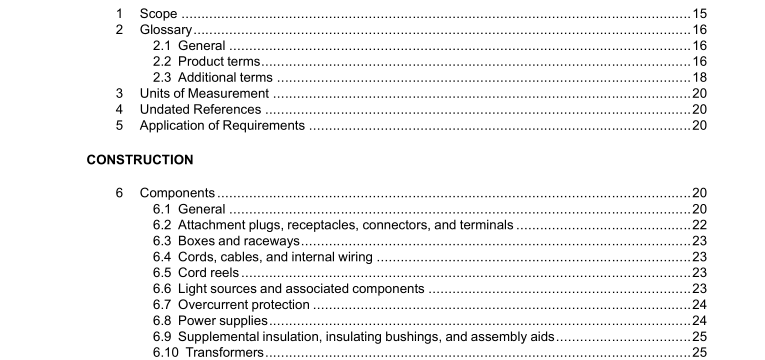UL 507-2020 pdf download.Electric Fans.
2.2.10 DOWN-DRAFT FAN – A fan intended for installation adjacent to a grill or stove top, and that draws smoke down into an exhaust duct. 2.2.11 DRAIN PUMP – A pump provided in an evaporative cooler, in addition to the recirculating pump(s), intended to periodically purge the reservoir of mineral laden water. 2.2.12 EVAPORATIVE COOLER (also referred to a swamp cooler or desert cooler) – An appliance used to lower the temperature and increase the humidity of air by using latent heat of vaporization, changing liquid water to water vapor. The evaporative cooler unit uses a fan to draw air through a wetted membrane, or pad, which provides a large surface area for the evaporation of water into the air. This appliance incorporates a fan, filter, or heater, or all of these components. Some evaporative coolers have provision for connection to a duct. 2.2.13 FLOOR INSERT FAN – An intake or exhaust fan installed in a raised floor. 2.2.14 HASSOCK FAN – A floor support fan resembling a foot rest. 2.2.15 COMMERCIAL DISPLAY BLOWER – Blower intended for use with commercial displays possessing an outlet intended to be exposed to normal atmosphere. 2.2.16 IMPELLER – An assembly of blades about an integral hub. 2.2.17 THROUGH-WALL FAN – A fan installed through the wall or other structure and intended to draw air from the outside or exhaust air from the inside. 2.2.18 LOW VOLTAGE COMPONENT FAN – A component fan intended to be used in isolated secondary circuits and rated a maximum of 30 V rms (42.2 V peak) or 60 V dc. 2.2.19 OUTER SHELL – A continuous casing which collects the air and guides the air stream towards the duct system of the building in case of exhaust installation, or towards the point(s) where the cleaned air is discharged back into the room in case of recirculating installation. Note: The air intake and the air discharge are not considered as openings in the outer shell. 2.2.20 PORTABLE APPLIANCE – A cord-connected appliance capable of being easily moved by hand from place to place (in normal use).
2.2.25 WALL-INSERT FAN – An intake or exhaust fan permanently attached in a wall without a sleeve. 2.2.26 WHOLE HOUSE FAN – A fan mounted on the attic-side of a ceiling, typically centrally located in a hallway. The fan is usually concealed behind a ceiling grill that opens and closes automatically. The fan is used to cool an entire house by drawing cooler outside air through open windows in the house and exhausting the hot room air through the attic to the building exterior. 2.2.27 WINDOW-MOUNTED FAN – A window fan or a box fan intended for installation in a window. 2.3 Additional terms 2.3.1 AIR DISTRIBUTION SYSTEM – For the purpose of determining smoke developed requirements for non-metallic enclosures and other parts of appliances covered by this Standard, an air distribution system is defined as a continuous passageway for the transmission of air that does not vent directly to the outdoors. For example, a building having several fans inter-connected with air ducts before venting to the outdoors. 2.3.2 APPLIANCE COUPLER – A single-outlet, female contact device that is attached to a flexible cord as part of a detachable power supply cord to be connected to an inlet. 2.3.3 ASKAREL – A generic term for a group of nonflammable synthetic chlorinated hydrocarbons used as electrical insulating media. Askarels of various compositional types are used. Under arcing conditions the gases produced, while consisting predominantly of noncombustible hydrogen chloride, can include varying amounts of combustible gases depending upon the askarel type. 2.3.4 BRANCH CIRCUIT, INDIVIDUAL – A branch circuit that supplies only one utilization equipment. 2.3.5 CABINET – That part of a unit that encloses insulated wiring, electrical enclosures, moving parts, motors, or enclosed electrical parts. 2.3.6 CONVENIENCE RECEPTACLE – Receptacle intended for the connection of an independent appliance or product.
2.3.13 OTHER SPACE USED FOR ENVIRONMENTAL AIR – Space used for environmental air-handling purposes other than ducts and plenums. It does not include habitable rooms or areas of buildings, the prime purpose of which is not air handling. The space over a hung ceiling used for environmental air handling purposes is an example of the type of other space to which this section applies. 2.3.14 OUTLET BOX – As used in this standard, the term “outlet box” includes an outlet box or any other supporting system, usually field supplied, intended to enclose splices and wiring devices or to support a fan. 2.3.15 PROTECTIVE CONTROL – A device or circuit, the operation of which is intended to prevent a hazardous situation during abnormal operation of the machine or equipment. 2.3.16 RISK OF ELECTRIC SHOCK – A risk of electric shock exists at any part when: a) The potential between the part and earth ground or any other accessible part is more than 30 V rms (42.4 V peak); and b) The continuous current flow through a 1500 ohm resistor connected across the potential exceeds 0.5 mA. 2.3.17 SINGLE-OPERATION DEVICE – A device that incorporates a bimetal that is calibrated to open the motor circuit upon reaching a certain temperature and is resettable only by cooling to minus 35° C (minus 31°F), or lower. 2.3.18 SPECIAL-USE RECEPTACLE – Receptacle intended for the connection of a specific component of the end-product appliance.UL 507-2020 pdf download.
UL 507-2020 pdf download
